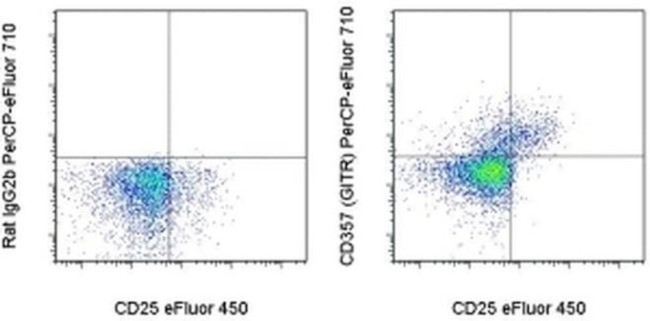Search Thermo Fisher Scientific
Invitrogen
CD357 (AITR/GITR) Monoclonal Antibody (DTA-1), PerCP-eFluor™ 710, eBioscience™
FIGURE: 1 / 1
CD357 (AITR/GITR) Antibody (46-5874-82) in Flow

Product Details
46-5874-82
Species Reactivity
Published species
Host/Isotype
Recommended Isotype Control
Class
Type
Clone
Conjugate
Excitation/Emission Max
Form
Concentration
Purification
Storage buffer
Contains
Storage conditions
Shipping conditions
RRID
Product Specific Information
Description: The DTA-1 monoclonal antibody reacts with mouse GITR, Glucocorticoid-Induced TNFR family gene, also known as TNFRSF18. In naive mice, GITR is expressed predominantly by CD4+CD25+ T regulatory cells (Treg) and by CD25+ CD4+ CD8- thymocytes. Stimulation of GITR with DTA-1 antibody abrogates Treg cell-mediated suppression. Although it does not deplete CD357 expressing cells in vivo, it has been shown to induce tumorogenesis. The removal of GITR-expressing Treg cells or the administration of DTA-1 resulted in organ specific autoimmune disease.
Applications Reported: This DTA-1 antibody has been reported for use in flow cytometric analysis.
Applications Tested: This DTA-1 antibody has been tested by flow cytometric analysis of mouse splenocytes. This can be used at less than or equal to 0.004 µg per test. A test is defined as the amount (µg) of antibody that will stain a cell sample in a final volume of 100 µL. Cell number should be determined empirically but can range from 10^5 to 10^8 cells/test. It is recommended that the antibody be carefully titrated for optimal performance in the assay of interest.
PerCP-eFluor® 710 emits at 710 nm and is excited with the blue laser (488 nm); it can be used in place of PerCP-Cyanine5.5. We recommend using a 710/50 bandpass filter, however, the 695/40 bandpass filter is an acceptable alternative. Please make sure that your instrument is capable of detecting this fluorochrome.
Fixation: Samples can be stored in IC Fixation Buffer (Product # 00-822-49) (100 µL cell sample + 100 µL IC Fixation Buffer) or 1-step Fix/Lyse Solution (Product # 00-5333-54) for up to 3 days in the dark at 4°C with minimal impact on brightness and FRET efficiency/compensation. Some generalizations regarding fluorophore performance after fixation can be made, but clone specific performance should be determined empirically.
Excitation: 488 nm; Emission: 710 nm; Laser: Blue Laser.
Filtration: 0.2 µm post-manufacturing filtered.
Target Information
Tumor necrosis factor receptor superfamily member 18 (TNFRSF18), also called GITR or AITR is a protein that in humans is encoded by the TNFRSF18 gene. It is mapped to 1p36.33. This gene encodes a member of the TNF-receptor superfamily. The encoded receptor has been shown to have increased expression upon T-cell activation, and it is thought to play a key role in dominant immunological self-tolerance maintained by CD25 (+)CD4 (+) regulatory T cells. Knockout studies in mice also suggest the role of this receptor is in the regulation of CD3-driven T-cell activation and programmed cell death. Three alternatively spliced transcript variants of this gene encoding distinct isoforms have been reported.
For Research Use Only. Not for use in diagnostic procedures. Not for resale without express authorization.
How to use the Panel Builder
Watch the video to learn how to use the Invitrogen Flow Cytometry Panel Builder to build your next flow cytometry panel in 5 easy steps.
Bioinformatics
Protein Aliases: CD357; Glucocorticoid-induced TNFR-related protein; PRO364; Tumor necrosis factor receptor superfamily member 18; UNQ319
Gene Aliases: AITR; Gitr; Tnfrsf18
UniProt ID: (Mouse) O35714
Entrez Gene ID: (Mouse) 21936

Performance Guarantee
If an Invitrogen™ antibody doesn't perform as described on our website or datasheet,we'll replace the product at no cost to you, or provide you with a credit for a future purchase.*
Learn more
We're here to help
Get expert recommendations for common problems or connect directly with an on staff expert for technical assistance related to applications, equipment and general product use.
Contact tech support

